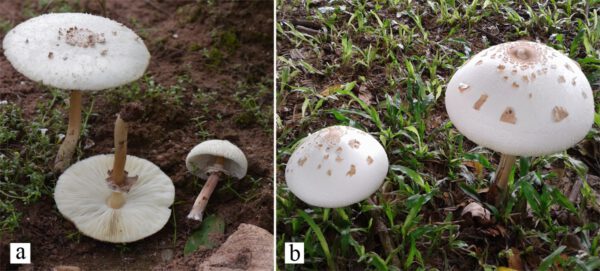Fungalpedia – Note 153 Chlorophyllum
Chlorophyllum Massee
Citation if using this entry: Sysouphanthong et al. (in prep) – Fungalpedia Basidiomycota 3. Mycosphere.
Index Fungorum, Facesoffungi, MycoBank, GenBank, Fig. 1–2
Classification: Fungi, Basidiomycota, Agaricomycotina, Agaricomycetes, Agaricales, Agaricaceae.
The genus Chlorophyllum, a saprobic genus of Agaricaceae Chevall., was established in 1898 to accumulate of the first concept of green-spored agaric mushrooms, and C. molybdites (G. Mey.) Massee is the type species (Massee 1898). Based on phylogenetic analysis Vellinga (2002) transferred 13 species from the genera Agaricus L., Endoptychum Czern., Lepiota (Pers.) Gray, Leucocoprinus Pat. and Macrolepiota Singer, including species with both green and white basidiospores; and agaricoid and secotioid habits were accepted in the revised concept of the genus. In recent investigations of Chlorophyllum based on multigene molecular phylogenetic analysis of ITS-LSU-rpb2-tef, six sections were accepted, which are sect. Chlorophyllum, sect. Ellipsospororum, sect. Endoptychorum (Czern.) Z.W. Ge, sect. Parvispororum Z.W. Ge, sect. Rhacodium Z.W. Ge and sect. Sphaerospororum Z.W. Ge; and colour of basidiospores are various from white, green to brown, and the habit are various from agaricoid, secotioid to gasteroid for revised concept (Crous et al. 2015, Ge et al. 2018, Loizides et al. 2020).
In the analysis of Chlorophyllum by Ge et al. (2018) and Sysouphanthong et al. (2021) based on combined sequences of ITS, 28S, rpb2 and tef1 showed that Chlorophyllum was a monophyletic genus containing species with agaricoid and secotioid forms. Based on newly discovered species and analysis of combined ITS, 28S, rpb2, and tef1 sequences by Loizides et al. (2020) it was found that species with gasteroid shapes, C. arizonicum (Shear & Griffiths) G. Moreno & Altés, C. levantinum Loizides, P. Alvarado & Konstantinou and C. lusitanicum G. Moreno, Muñ.-Moh., Manjón, Carlavilla & Altés clustered in sect. Sphaerospororum, where the type species is an agaricoid form C. sphaerosporum Z.W. Ge & Zhu L. Yang and Secotium gueinzii Kunze with hemiangiocarpic form is located in sect. Chlorophyllum with an agaricoid habit.
The present concept of Chlorophyllum is a saprobic genus, white to green and brown basidiospores, consisting of agaricoid to secotioid and gasteroid forms or habits; and 21 species are accepted (Ge et al. 2018, He et al. 2019, Loizides et al. 2020, Dutta et al. 2020).
Synonymy: Endoptychum Czern.
Type species: Chlorophuyllum molybdites (G. Mey.) Massee
Other accepted species:
Chlorophyllum abruptibulbum (R. Heim) Vellinga
Chlorophyllum africanum Z.W. Ge & A. Jacobs
Chlorophyllum agaricoides (Czern.) Vellinga
Chlorophyllum alborubescens (Hongo) Vellinga
Chlorophyllum arizonicum (Shear & Griffiths) G. Moreno & Altés
Chlorophyllum bharatense Sathe & S.M. Kulk.
Chlorophyllum brunneum (Farl. & Burt) Vellinga
Chlorophyllum demangei (Pat.) Z.W. Ge & Zhu L. Yang
Chlorophyllum globosum (Mossebo) Vellinga
Chlorophyllum hortense (Murrill) Vellinga
Chlorophyllum humei (Murrill) Vellinga
Chlorophyllum levantinum Loizides, P. Alvarado & Konstantinou
Chlorophyllum lusitanicum G. Moreno, Muñ.-Moh., Manjón, Carlavilla & Altés
Chlorophyllum madagascariense (L.M. Dufour) Heinem.
Chlorophyllum mammillatum (Murrill) Vellinga
Chlorophyllum molybdites (G. Mey.) Massee
Chlorophyllum morganii (Peck) Massee
Chlorophyllum neomastoideum (Hongo) Vellinga
Chlorophyllum nothorhacodes Vellinga & Lepp
Chlorophyllum olivieri (Barla) Vellinga
Chlorophyllum palaeotropicum Z.W. Ge & A. Jacobs
Chlorophyllum pseudoglobosum J. Sarkar, A.K. Dutta & K. Acharya
Chlorophyllum rhacodes (Vittad.) Vellinga
Chlorophyllum shimogaense Sathe & S.M. Kulk.
Chlorophyllum sphaerosporum Z.W. Ge & Zhu L. Yang
Chlorophyllum squamulosum A.K. Dutta, Soumili Bera & K. Acharya
Chlorophyllum subfulvidiscum (Murrill) Vellinga
Chlorophyllum subrhacodes (Murrill) Vellinga
Chlorophyllum venenatum (Bon) C. Lange & Vellinga
Figure 1. Chlorophyllum molybdites in situ. a,b= MFLU 12-1775. Photos from Sysouphanthong et al. (2021).
Figure 2. Chlorophyllum molybdites (MFLU 12-1775). a. basidiomata. b. basidiospores. c a trichodermal pileus covering. Scale bars: a-b= 10 mm, a-e = 10 µm. Line drawing from Sysouphanthong et al. (2021).
References
Crous PW, Wingfield MJ, Le Roux JJ, Richardson DM, Strasberg D et al. 2015 – Fungal Planet description sheets: 371–399. Persoonia 35, 264–327.
Dutta AK, Bera S, Paloi S, Rakshit S, Tarafder E, Sherpa AR, Acharya K 2020 – Lepiotaceous fungi ofWest Bengal, India: The genus Chlorophyllum. Phytotaxa 451, 113–131.
Ge ZW, Jacobs A, Vellinga EC’ Sysouphanthong P, van der Walt R, Lavorato C, An YF, Yang ZL 2018 – A multi-gene phylogeny of Chlorophyllum (Agaricaceae, Basidiomycota): new species, new combination and infrageneric classification. MycoKeys 32, 65–90.
He MQ, Zhao RL, Hyde KD, Begerow D, Kemler M et al. 2019 – Notes, outline and divergence times of Basidiomycota. Fungal Diversity 99, 105–367.
Loizides M, Alvarado P, Polemis E, Dimou DM, Zervakis DG et al. 2020 – Multiple evolutionary origins of sequestrate species in the agaricoid genus Chlorophyllum. Mycologia 112, 400–422.
Massee GE 1898 – Fungi exotici, I. Bulletin of Miscellaneous Informations of the Royal Botanical Gardens Kew 138, 135.
Sysouphanthong P, Thongklang N, Liu JK, Vellinga EC 2021 – Description of lepiotaceous fungal species of the genera Chlorophyllum, Clarkeinda, Macrolepiota, Pseudolepiota, and Xanthagaricus, from Laos and Thailand. Diversity 13, 666.
Vellinga EC 2002 – New combinations in Chlorophyllum. Mycotaxon 83, 415–417.
Entry by
Phongeun Sysouphanthong, Center of Excellence in Fungal Research, Mae Fah Luang University, Chiang Rai 57100, Thailand
(Edited by Kevin D Hyde)
Published online 9 October 2023

